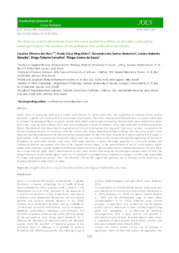Do chitosan and its derivatives have the same protective effect on drought-contrasting maize genotypes? An analysis of physiological and production processes.
Do chitosan and its derivatives have the same protective effect on drought-contrasting maize genotypes? An analysis of physiological and production processes.
Autoria: REIS, C. O. dos; MAGALHAES, P. C.; AMBROSIO, A. dos S.; ALMEIDA, L. G.; CARVALHO, D. T.; SOUZA, T. C, de
Resumo: Water stress is among the most severe abiotic stress factors for maize production. The application of chitosan causes various responses in plants, as a function of its structure and concentration. Therefore, chemical modifications were proposed in this study to enhance the biological effects on plants. Hybrid maize plants with drought-contrasting characteristics, were subjected to water deficit and spraying with chitosan (CHI) and semi-synthesized chitosan derivatives, N‑Succinyl (SUC) and N,O‑Dicarboxymethyl (MCA). The obtained data show that the application of CHI and its derivatives (0.5 mg.plant-1 ) led to an increase in production for the two evaluated hybrids in comparison with the control under stress. Regarding leaf gas exchange, over the stress period, it was observed that the application of the MCA derivative yielded greater Pn than the other treatments in plants subjected to drought, in both hybrids. In the evaluation of chlorophyll content, there was an increase in this content through the application of CHI and its derivatives for both maize hybrids under study. With water recovery in plants, the water potential (Ψmd) of those treated with chitosan derivatives was greater than that of the irrigated control plants. In the quantification of proline concentration, higher values were observed in plants treated with MCA derivatives for the drought-sensitive hybrid. Chitosan derivatives, SUC and MCA, were responsible for higher starch concentrations in both maize hybrids. Evaluating the morphological characteristics of roots, the drought-tolerant hybrid showed higher means for all parameters evaluated when subjected to drought, and MCA was responsible for longer root length and greater mean root diameter. The results support the potential use of chitosan and its derivatives to increase tolerance to water deficit in maize.
Ano de publicação: 2022
Tipo de publicação: Artigo de periódico
Unidade: Embrapa Milho e Sorgo
Observações
1 - Por padrão são exibidas publicações dos últimos 20 anos. Para encontrar publicações mais antigas, configure o filtro ano de publicação, colocando o ano a partir do qual você deseja encontrar publicações. O filtro está na coluna da esquerda na busca acima.
2 - Para ler algumas publicações da Embrapa (apenas as que estão em formato ePub), é necessário ter, no celular ou computador, um desses softwares gratuitos. Sistemas Android: Google Play Livros; IOS: iBooks; Windows e Linux: software Calibre.
Acesse outras publicações
Acesse a Base de Dados da Pesquisa Agropecuária (BDPA) para consultar o acervo completo das bibliotecas da Embrapa.

